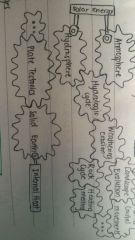![]()
![]()
![]()
Use LEFT and RIGHT arrow keys to navigate between flashcards;
Use UP and DOWN arrow keys to flip the card;
H to show hint;
A reads text to speech;
32 Cards in this Set
- Front
- Back
- 3rd side (hint)
|
Earth System Science |
Hollistic approach to studying the Earth as a whole ________ of many _________________ |
System; interacting parts |
|
|
The System Concept |
Any portion of the universe that can be ____________ from the rest of the universe for the purpose of observing and measuring changes |
Set apart |
|
|
The System Concept |
It must have a ___________ that sets it apart from its surroundings - It prevents ____________ |
Boundary; exchanging |
|
|
Isolated System Closed System Open System |
Types of System Concept |
|
|
|
Closed System |
Permits exchange of _______ (but not matter) ______________ exchange of matter relative to the mass of the system E.g. _________ |
Energy; negligible; earth |
|
|
1. Atmosphere -____________ 2. Hydrosphere -+_______________ 3. Geosphere -_______________ 4. Biosphere -+_______________ , +___________ |
Earth's Subsystems or _____________ |
Mixture of gases Cryosphere Physical elements Anthrosphere Technosphere Reservoirs |
|

Overview of Earth Systems |
Earth's subsystems are ______ systems |
Open |
|
|
Interaction ★ various air masses |
Interaction ★ Earth's Subsystems Atmosphere ←→ Atmosphere |
|
|
|
Input of water vapor and stored solar heat |
Interaction ★ Earth's Subsystems Atmosphere ←→ Hydrosphere |
How hydrosphere affects atmosphere |
|
|
Gases from respiration |
Interaction ★ Earth's Subsystems Atmosphere ←→ Biosphere |
|
|
|
Input of stored solar heat; Landscapes affect air movement |
Interaction ★ Earth's Subsystems Atmosphere ←→ Geosphere |
|
|
|
Surface currents driven by wind; Evaporation |
Interaction ★ Earth's Subsystems Hydrosphere ←→ Atmosphere |
|
|
|
Hydrologic cycle |
Interaction ★ Earth's Subsystems Hydrosphere ←→ Hydrosphere |
|
|
|
Removal or addition of materials by organisms |
Interaction ★ Earth's Subsystems Hydrosphere ←→ Biosphere |
|
|
|
Source of solid and dissolved materials |
Interaction ★ Earth's Subsystems Hydrosphere ←→ Geosphere |
|
|
|
Gases for/from respiration; dispersal of spores, pollen and seeds by wind |
Interaction ★ Earth's Subsystems Biosphere ←→ Atmosphere |
|
|
|
Water for life |
Interaction ★ Earth's Subsystems Biosphere ←→ Hydrosphere |
|
|
|
Global ecosystems; Food cycles; Energy transfers |
Interaction ★ Earth's Subsystems Biosphere ←→ Biosphere |
|
|
|
Source of mineral nutrients; Modification of ecosystems by plate movements |
Interaction ★ Earth's Subsystems Biosphere ←→ Geosphere |
|
|
|
Weathering by wind erosion; Transport of water vapor for precipitation of wind and snow |
Interaction ★ Earth's Subsystems Geosphere ←→ Atmosphere |
|
|
|
Precipitation, weathering and erosion |
Interaction ★ Earth's Subsystems Geosphere ←→ Hydrosphere |
|
|
|
Modification of weathering and erosion processes; formation of soil |
Interaction ★ Earth's Subsystems Geosphere ←→ Biosphere |
|
|
|
Plate tectonics |
Interaction ★ Earth's Subsystems Geosphere ←→ Geosphere |
|
|
|
Feedback |
A system response that occurs when the _______ of the system also serves as an ________ Leads to changes in the state of the system Two Types: 1. __________ 2. __________ |
Output; Input 1. Negative Feedback 2. Positive Feedback |
|
|
Hydrothermal Vent |
What sustains life on Earth?
Example: _________ |
Lake Vostok, Antartica |
|
|
Energy Flow Material Cycling |
Two secrets of survival Interactions ★ the Earth's subsystems are evident in these processes |
|
|
|
Renewable Source of Energy |
Energy through subsystems can be harnessed for use in human societies making a ___________________ |
|
|
|
Biogeochemical Cycles |
Pathway by which a _________ element moves through both biotic and abiotic components of the earth (geo = atmo-, geo- and hydrosphere) |
Physical |
|
|
Hydrologic Cycle (Water Cycle) |
Movement of water through subsystems |
|
|
|
Carbon Cycle |
Movement of carbon through subsystems |
|
|
|
Nitrogen Cycle |
Movement of nitrogen through subsystems |
|
|
|
Phosphorus cycle |
Movement of phosphorus through subsystems |
|

